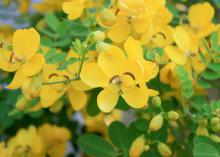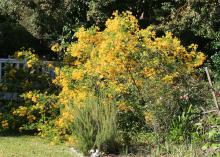Information Possibly Outdated
The information presented on this page was originally released on December 17, 2012. It may not be outdated, but please search our site for more current information. If you plan to quote or reference this information in a publication, please check with the Extension specialist or author before proceeding.
Winter cassia brings profusion of blooms
Every year, I look forward to the time when winter cassia begins blooming. The tropical-looking flowers are sure to create winter interest wherever they are planted in the landscape.
Winter cassia is one of those plants with show-stopping qualities, especially considering its prolific blooms in the winter. Their effect is heightened because the brightly colored blooms seem to appear all of a sudden out of nowhere.
Beginning in November, winter cassia’s golden-yellow flowers are displayed in spike-like clusters, each with up to 12 individual blossoms. Each flower has five petals, and the curved shapes of the stamens and pistils add to the landscape interest.
Flower clusters form toward the ends of the slender branches. Sometimes the flower production is so heavy that the branches are pulled down, giving plants a vase-shaped form. This effect is accentuated after a rain or heavy dew.
The prolific flower production also makes winter cassia a must for the butterfly garden. Many late-season butterflies enjoy the flowers as much as home gardeners do.
Winter cassia’s compound foliage is interesting and consists of three to five pairs of oval-shaped leaflets. The foliage is a deep green in the summer, but falling temperatures turn these leaflets a greenish-yellow. While the leaf shape and color do have landscape interest, winter cassia primarily fills in garden gaps and provides a consistent backdrop for more showy summer plants.
Because of the growth habit of winter cassia, the base of the shrub often can look a little bare. Planting underneath this shrub with flowering annuals or reliable flowering perennials will create interest until winter cassia’s late-fall explosion of color.
Plant in the full sun to be rewarded with the best flower production. Be sure to select a location with good drainage, as winter cassia does not like wet feet. A raised bed is the solution for many less-than-ideal garden soil conditions.
While overwatering causes problems, so will under-watering. Winter cassia does not tolerate drought conditions very well. Consistent garden soil moisture is key to optimum plant growth. Each spring, top dress with good-quality compost or sprinkle a handful of controlled-release fertilizer to keep your winter cassia healthy.
Winter cassia should be considered a hardy perennial into at least zone 8, where it will freeze back and regrow the following spring. Once temperatures start to cool, apply a layer of pine straw mulch around the base of the plant to help provide insulation.
The winter season can be dry, so water once a month if there has not been much rainfall. This is a good practice for winter cassia and all of our landscape trees and shrubs in the winter.









